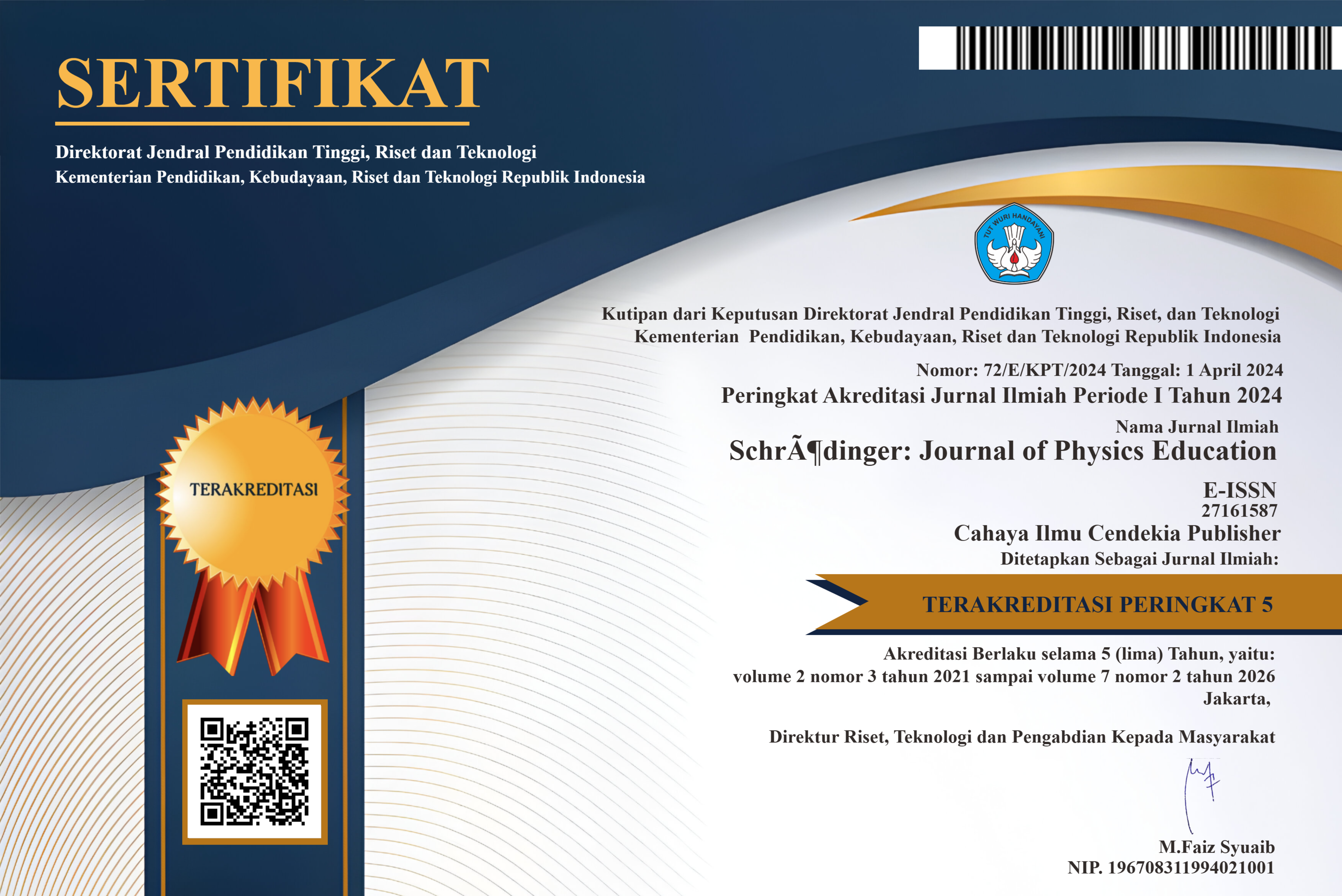E-Module Based Guided Inquiry: Business And Energy For Senior High Schools
Abstract
Research Objectives: This study aims to develop a Guided Inquiry-based Physics module on work and energy material for class X SMA and to find out students' perceptions of the media being developed.
Methodology: This research is research development (Research and Development) using the 4D development model (Define-Design-Development-Dissemination). However, this research was only carried out up to the Development stage. The research instrument used was a student needs questionnaire. Data were analyzed using descriptive statistical analysis techniques. The subjects of this development research were students of class X IPA 3 in 2018. The resulting media has specifications in the .exe format which can be operated on a computer/laptop without installing PageFlip Professional 3D software.
Main Findings: The results of the development trial show that the Physics electronic module can increase students' interest in the Physics learning process in the material of work and energy. Based on the results of the research, it can be concluded that the Guided Inquiry-based Physics electronic module on work and energy material for class X SMA that was developed is suitable for use as an independent or additional learning medium in the learning process of students.
Novelty/Originality of Research: The importance of innovation in learning is to attract students' interest and motivation in learning, therefore, the need for new innovations carried out by teachers in learning that they are capable of teaching.
References
U. Lestari, Astalini, dan Darmaji. “Deskripsi Keterampilan Proses Sains Mahasiswa Pendidikan Fisika Universitas Jambi Pada Kegiatan Praktikum Fisika Dasar I”, Universitas Jambi, pp. 1-10.
A. R. Putri, Maison, dan Darmaji. “Kerjasama dan Kekompakan Siswa dalam Pembelajaran Fisika di Kelas XII MIPA SMAN 3 Kota Jambi”. Jurnal Edufisika, vol. 3, no. 2, pp. 32-40, 2018.
Darmaji, D. A. Kurniawan, and Irdianti. “Physics education students’ science process skills”. International Journal of Evaluation and Research in Education, vol. 8, no. 2, pp. 293-298, 2019.
Maison, M. D. W. Ernawati, R. S. Budiarti, W. Kurniawan, Y. Ningsih, T. O. Puspitasari, N. Jannah, and D. S. Putra, “Learning In Nature Science: Social Implications, Normality Of Scientist, Attitudes Towards Investigation Of Natural Science, And Interest Adds To Science Learning Time”, International Journal Of Scientific & Technology Research, vol. 8, no. 12, pp. 1478-1484, 2019.
Darmaji, D.A. Kurniawan, and A. Suryani. “Effectiveness of Basic Physics II Practicum Guidelines Based On Science Process Skills”. Jurnal Ilmu Pendidikan Fisika, vol. 4, no. 1, pp. 1-7, 2019.
Y. D. Puspitarini., and M. Hanif, “Using learning media to increase learning motivation in elementary school,” Anatolian Journal of Education, vol. 4, no. 2, pp. 53-60, 2019.
A. E. E. Sobaih., A. M. Hasanein., and A. Elnasr, “Responses to COVID-19 in higher education: Social media usage for sustaining formal academic communication in developing countries,” Sustainability, vol. 12, no. 16, pp. 6520, 2020.
S. Suyadi, Strategi Pembelajaran Pendidikan Karakter. Bandung: PT Remaja Rosdakarya.
S. Amri., I. K. Ahmadi, Proses Pembelajaran Kreatif dan Inovatif dalam Kelas. Jakarta: PT. Prestasi Pustakaraya, 2010.
B. M. E. Jati, Pengantar Fisika 1. Yogyakarta: Gadjah Mada University Press, 2013.
Darmaji, D.A. Kurniawan, Astalini, and N.R. Nasih. “Persepsi Mahasiswa pada Penuntun Praktikum Fisika Dasar II Berbasis Mobile Learning”. Jurnal Pendidikan, vol. 4, no. 4, pp. 516-523, 2019.
Astalini, Darmaji, W. Kurniawan, K. Anwar, and D. A. Kurniawan. “Effectiveness of Using E-Module and E-Assessment”. iJIM, vol. 13, no. 9, pp. 21-39, 2019.
S. Sugiyono, Metode Penelitian Kuantitatif, Kualitatif, dan R&D. Bandung: Alfabeta, 2016
E. Mulyatiningsih, Riset Terapan Bidang Pendidikan & Teknik. Yogyakarta: UNY Press
S. Arikunto, Dasar-Dasar Evaluasi Pendidikan. Jakarta: Bumi Aksara, 2006.
S. Arikunto, Prosedur Penelitian (Suatu Pendekatan Praktik). Jakarta: Renika Cipta, 2013.
Copyright (c) 2023 Darwita Hendriyani

This work is licensed under a Creative Commons Attribution-NonCommercial 4.0 International License.
Authors who publish with this journal agree to the following terms:
- Authors retain copyright and acknowledge that the Schrödinger: Journal of Physics Education is the first publisher licensed under a Creative Commons Attribution 4.0 International License.
- Authors are able to enter into separate, additional contractual arrangements for the non-exclusive distribution of the journal's published version of the work (e.g., post it to an institutional repository or publish it in a book), with an acknowledgment of its initial publication in this journal.
- Authors are permitted and encouraged to post their work online (e.g., in institutional repositories or on their website) prior to and during the submission process, as it can lead to productive exchanges and earlier and greater citation of published work.






.png)
.png)








.png)
.png)
.png)







